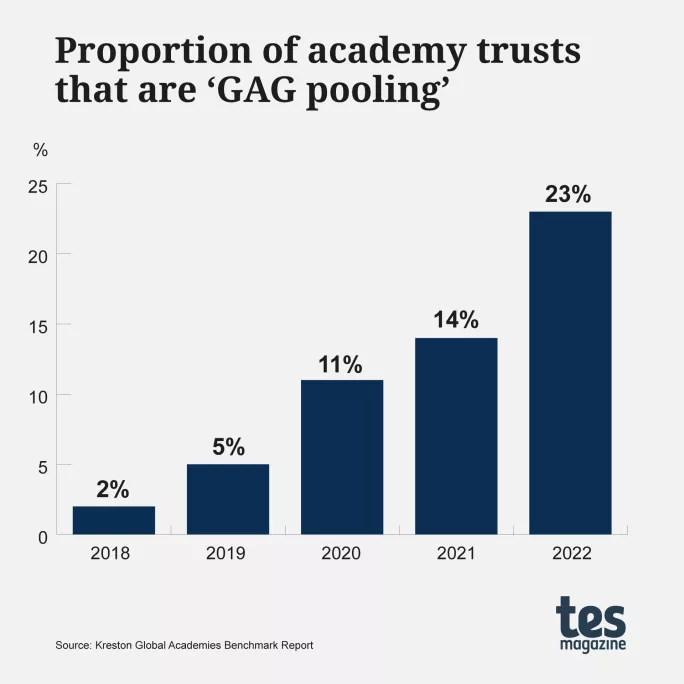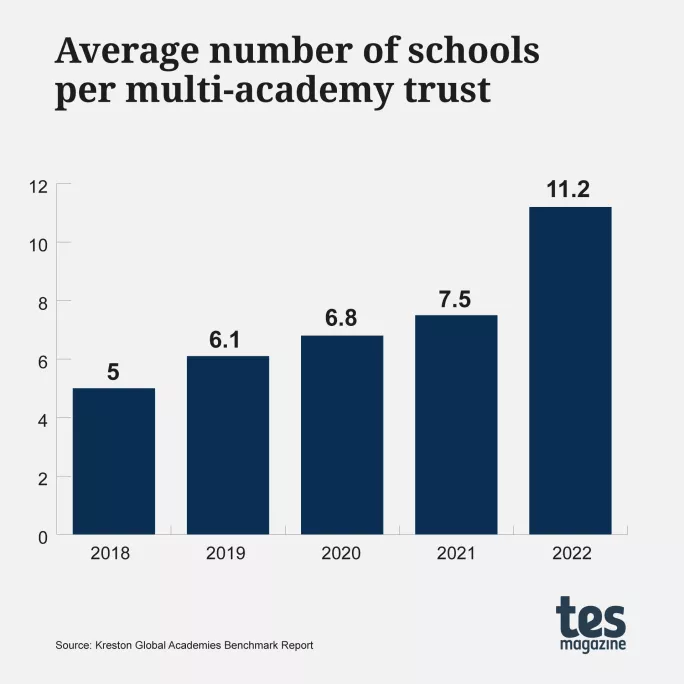
Half of primary single-academy trusts went into deficit last year

Nearly half of single-academy trusts in the primary sector (47 per cent) reported in-year deficits for 2021-22, according to a major new report.
The 11th annual Kreston Global Academies Benchmark Report, published today, shows a stark contrast between single- and multi-academy trusts’ finances last year, and highlights “growing nervousness” in academy trusts about the sector’s future finances.
It shows that academy trusts have managed to make “significant surpluses” overall this year, but that 88 per cent of trusts “are expecting future reductions in total income”.
The report also says that this is the first time in four years that, on average, in-year deficits have been seen in primary single-academy trusts (SATs).
- School funding: Schools wait “too long” for cost-cutter help
- Budget: Schools to get an extra £2.3 billion over next two years
- Background: “Extreme” costs and “political instability” disrupt MAT investment
It says this is down to a small number of primary SATs with very large deficits, resulting from capital and maintenance expenditure, dragging the overall average down.
This year’s report also says that average total staff costs per pupil increased for all trusts.
But it adds that many trusts submitted their three-year budget forecasts before the end of term in July 2022, prior to the Department for Education announcement on teachers’ pay.
Below are some of the other key findings in today’s report, which pulls together data from more than 320 trusts representing more than 2,400 schools.
1. Primary single-academy trusts hit by ‘staggering’ supply costs
Primary SATs have seen a “staggering increase in supply teaching costs, up 76 per cent from 2020-21”, the report reveals.
It adds: “With primary schools having less ability to draw on staff from other departments to cover staff absences, they have been disproportionally hit by the cost of supply cover as pupils returned to school; restrictions were lifted and therefore sickness increased.”
Secondary SATs have only seen the costs increase by 8 per cent and MATs by 16 per cent.
2. Falling pupil numbers a concern in primary sector
The challenge of falling pupil numbers could become “acute” for primary schools in the years ahead, the report notes.
It highlights the Office for National Statistics reporting that numbers attending primary and nursery schools peaked in 2019 and are predicted to fall by at least 12 per cent in the next six years.
Pam Tuckett, chair of Kreston Global’s academies group and head of education at accountants Bishop Fleming, said: “We have already seen many primary schools having to restructure to cater for lower numbers of pupils, and therefore falling income. Although Covid-19 funding has provided some protection, this is an issue which could have a much longer-term impact for the sector as a whole.”
3. Big MATs faring better financially
Kreston’s analysis shows that a significant proportion of primary SATs have reported in-year deficits for 2021-22, compared with large multi-academy trusts (MATs) - those with other 7,500 pupils - that are “faring far better financially”.
According to the report, these larger trusts achieved surpluses broadly in line with 2021, when the average in-year financial surplus doubled to £1.7 million.
The report explains that this could partly be because trusts of this size receive School Condition Allocation (SCA) funding, which means they do not have to make any additional contributions to secure capital funding.
In contrast, smaller trusts apply to the Condition Improvement Fund (CIF), which requires individual schools to make financial contributions in the form of bids to secure funding for projects.
A Tes investigation last year revealed that the points system “heavily favours” those that can provide higher contributions.
And despite the disparity, Ms Tuckett said that nearly all trusts spoken to in compiling the report ”expressed serious concern over the future financial position of their trusts”.
4. Seven in 10 MATs expect to grow this year
Some 70 per cent of MATs surveyed said they expected to grow in 2022-23, with 92 per cent forecasting growth by the end of 2023-24.
Over 5 per cent of trusts expected to grow by 7-plus schools in 2023 and also 7-plus schools in 2024.
The Kreston report says there has been a slowdown in the number of schools moving between trusts.
It highlights that 176 academies (1.8 per cent of open academies) moved trust in 2021-22 and only 23 per cent attracted grant funding - a massive decrease from the peak of 63 per cent back in 2014-15. The actual level of funding was £1.73 million, substantially down on the £3.16 million in 2020-21.
Ms Tuckett said: “These figures underline the increasing difficulty in securing funding to take on new schools, and highlight the critical due diligence needed to ensure new schools will be financially viable.”
5. CEO pay rises in smaller trusts
The Kreston report notes that the movement on MAT chief executives’ salaries varied depending on the size of MAT.
“For small and medium MATs there has been a small increase of 3.9 per cent and 4.4 per cent respectively,” it says.
“However, in the large MATs average CEO salary has, in fact, fallen by 2.5 per cent. There is a lot of fluidity in the sector and this may account for the reduction. As with secondary SATs, this could also be because less experienced CEOs are moving into these roles.”
The average overall CEO/headteacher salary for the trusts responding to the Kreston report has increased year on year from £100,744 in 2017-18 to £127,969 in 2021-22.

6. Increased spending as reserves fall
Overall, MAT revenue reserves per pupil have fallen by 7.4 per cent from £802 to £743, while there has been a 30 per cent increase in capital spending.
Ms Tuckett said the increased spending reflected “the struggle” trusts had to spend capital grants last year as they emerged from the pandemic.
The Education and Skills Funding Agency (ESFA) has also indicated that reserves of over 20 per cent of income could be subject to scrutiny, and Ms Tuckett added that trusts with above this level of cash were “thinking about how to spend or designate their funds so they fall below this threshold”.
7. Centralised ‘GAG pooling’ becoming more common
The proportion of multi-academy trusts “GAG pooling” has almost doubled compared with the last Kreston report for 2020-21.
Today’s report shows 23 per cent of MATs were GAG pooling in 2021-22 compared with just 14 per cent last year.
GAG pooling describes the process of moving each school’s general annual grant (GAG) to the centre of the trust and then redistributing it to schools based on the MAT’s decision making about where resources should be spent.

8. MATs becoming more centralised
The Kreston report also highlights an increase in the number of MATs describing themselves as being fully centralised.
“In previous years we have seen a slow shift towards centralisation,” it says. “It is logical that as MATs grow, they recognise the synergies which can be obtained through centralisation and the opportunity to improve control by streamlining processes.
“Unsurprisingly, this trend has continued with only 9 per cent of MATs being categorised as operating any form of a decentralised model, while 55 per cent are considered to be fully centralised.”
9. Difficulty recruiting chief finance officers
Almost two-thirds of trusts surveyed for the report were taking more than three months to recruit chief financial officers to central teams, with a quarter taking more than four months.
“We know of one example where the trust took nearly a year to recruit to a senior finance role. This is one of the most difficult areas to recruit as they are competing with industry and are struggling to pay competitive rates, especially as CFOs are becoming more qualified and their skills are transferable to other sectors,” the report says.
It notes that average CFO pay has increased from £50,995 in 2017-18 to £72,748 in 2021/22 in MATs.
10. The number of MATs has peaked and will decline as trusts consolidate
The report also says that “it is likely that we have now seen the peak in the number of individual MATs as consolidation within the sector takes place”.
It adds that, based on the government-published data, as of 31 August 2022 there were 8,672 schools in 1,191 MATs, which was a slight reduction on the previous year, when there were 1,198 MATs.
In terms of what will happen to the growth of MATs in the future, the report says that client feedback suggests the sector “recognises the benefits of MATs, and many SATs are continuing their discussions to join MATs. However, some are clearly waiting on the government to clarify their policy towards academies and the 2030 target”.
The government set a target that all schools should be in or moving towards MATs by 2030 in last year’s Schools White Paper, but since the scrapping of the Schools Bill, which followed this paper, it has been unclear if the target still remains.
Data shows the average number of schools per trust in the Kreston report has more than doubled from five in 2018 to 11.2 in 2022.

You need a Tes subscription to read this article
Subscribe now to read this article and get other subscriber-only content:
- Unlimited access to all Tes magazine content
- Exclusive subscriber-only stories
- Award-winning email newsletters
- Unlimited access to all Tes magazine content
- Exclusive subscriber-only stories
- Award-winning email newsletters
You need a subscription to read this article
Subscribe now to read this article and get other subscriber-only content, including:
- Unlimited access to all Tes magazine content
- Exclusive subscriber-only stories
- Award-winning email newsletters
- Unlimited access to all Tes magazine content
- Exclusive subscriber-only stories
- Award-winning email newsletters
topics in this article



